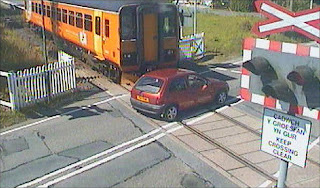Typical arrangement of modern level crossing safety system
Level crossings were originally manned by a man in a booth who, upon the approach of a train, would either wave a flag to warn of the approach or clear livestock from the tracks. The first mechanical warning gate systems were more concerned with clearing and securing the track from livestock and so would incorporate an actual gate to physically prevent animals from occupying the tracks.
Example of older-style level crossing
As the automobile came to dominate the roadways, the mechanical warning system became focused on drawing attention to the motorist of approaching train traffic and relying on the discretion of the driver to not occupy the track area.
Signal styles vary from county to country as to levels of traffic impediment, from a simple manually operated gate to much more complex systems.
Signal styles vary from county to country as to levels of traffic impediment, from a simple manually operated gate to much more complex systems.
Warning Cross
Manually Operated Gate
Protected Pedestrian Level Crossing
Belgian crossing sign
A 'Wig-Wag' Type Signal
Gate with Guard
Raised Panel Gate

.jpg)







